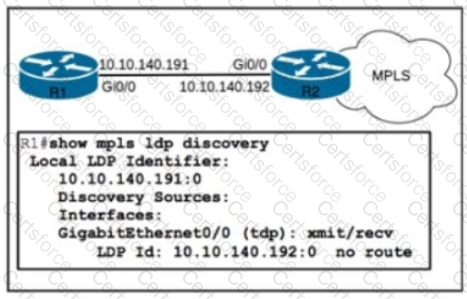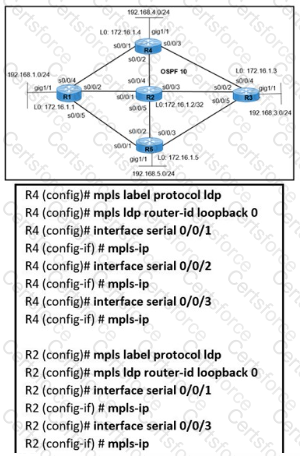Refer to the exhibit.

While configuring router 2 with all the default values, a network engineer cannot see any route received in router 1. How should the engineer solve the issue?
Refer to the exhibit.

A network engineer must optimize link failures on the OSPF routing domain. The solution must follow RFC 5286. and downtime must be no more than 50 ms. All known subnets on R1 must be protected. Which solution must the engineer implement on R1?
Refer to the exhibit.

Router 1 has established an SR-TE tunnel with router 2. Which statement describes this
configuration?
Which technique should be permitted on ASA Firewall to allow MSDP Peering?
Refer to the exhibit.

Routers R1 and R2 are RFC 5036-based MPLS-enabled core routers MPLS IP is enabled globally on both routers OSPF with area 0 configuration is used as an interior routing protocol between the routers After new services were enabled on the MPLS network, LDP connectivity failed on R1 TCP/UDP port 711 is confirmed to be open Which two actions must the engineer take to correct the problem? (Choose two.)
Drag and drop the features about multicast from the left onto the multicast protocols on the right. Not all options ate used.

RPL has several fundamental capabilities that differ from those present in configurations oriented to traditional route maps Routing policy language introduces the notion of sets Which group of set types is valid in RPL?
Refer to the exhibit.

Which task must you perform on interface g1/0/0 to complete the SSM implementation?
What are two features of dual-stack? (Choose two.)


Refer to the exhibit. MPLS traffic from 192.168.4.0/24 to 192.168.5.0/24 is failing to pass over the link from R4 to R2. The engineer verified that:
Cisco Express Forwarding Is enabled on all routers.
All routers reach all networks via OSPF.
MPLS traffic from 192.168.1.0/24 to 192.168.3.0/24 is passing normally over the link from R1 to R2.
Which action resolves the issue?